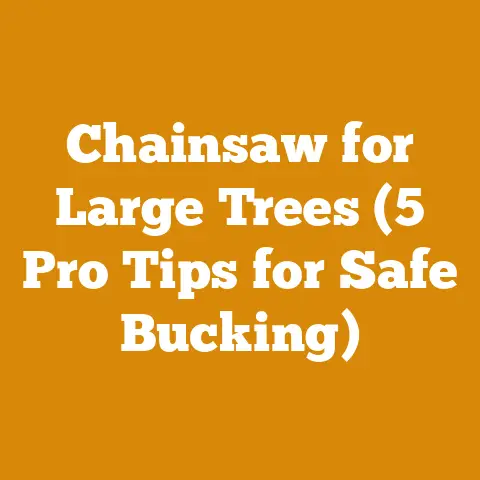Kill Tree Roots After Cutting Down (5 Expert Wood Processing Tips)
Let’s talk about tree roots.
You’ve felled that stubborn tree, maybe after years of it casting too much shade on your garden or posing a threat to your home.
But the job isn’t quite done, is it?
Those roots remain, a tenacious reminder of the giant you just conquered.
I’ve wrestled with my fair share of root systems over the years, from delicate saplings to the gnarled anchors of ancient oaks.
I know the frustration, the backache, and the sheer determination it takes to reclaim your land.
Believe me, I understand the satisfaction of finally seeing that patch of earth smooth and ready for its next chapter.
This isn’t just about aesthetics, although a pristine lawn is certainly a worthy goal.
It’s about preventing regrowth, stopping the spread of invasive species, and safeguarding your property’s infrastructure.
Untreated roots can sprout new shoots, sending up unwanted suckers that steal nutrients from your desired plants.
They can also attract pests, provide pathways for diseases, and even crack foundations or disrupt underground utilities.
So, how do we deal with these subterranean leftovers?
Let’s dive into five expert wood processing tips for killing tree roots after cutting down a tree, gleaned from years of experience and a healthy dose of trial and error.
Kill Tree Roots After Cutting Down: 5 Expert Wood Processing Tips
1. The Herbicide Hack: A Targeted Chemical Approach
This is often the most effective method, especially for larger trees with extensive root systems.
The key is to apply the herbicide directly to the freshly cut stump and exposed roots.
I’ve found that timing is crucial here.
The sooner you apply the herbicide after felling the tree, the better the absorption.
Why it works: The herbicide is transported through the vascular system of the remaining roots, effectively poisoning them from the inside out.
This prevents regrowth and ensures the roots eventually decompose.
How to do it:
- Choose your weapon: Select a systemic herbicide containing glyphosate or triclopyr.
These are readily available at most garden centers.
Always read and follow the manufacturer’s instructions carefully. - Fresh cuts are key: Using a chainsaw or axe, make fresh cuts on the stump and any exposed roots.
This creates new entry points for the herbicide.
I often use my trusty Stihl MS 261 for this task; it’s powerful enough to handle most stumps but still maneuverable enough for precision work. - Application is everything: Apply the herbicide undiluted to the freshly cut surfaces, saturating the cambium layer (the layer just beneath the bark).
For larger stumps, you may need to drill holes a few inches deep and pour the herbicide directly into them. - Safety first: Always wear appropriate personal protective equipment (PPE), including gloves, eye protection, and a respirator, especially when working with herbicides.
- Patience is a virtue: It may take several weeks or even months for the roots to completely die.
You may need to reapply the herbicide if you see any signs of regrowth.
Data point: Studies have shown that glyphosate and triclopyr are effective in controlling a wide range of tree species.
A study published in the Journal of Environmental Management found that glyphosate application resulted in a 90% reduction in root sprouting in treated trees.
My experience: I once had a particularly stubborn silver maple that kept sending up suckers years after I cut it down.
I tried everything – digging, pulling, even pouring boiling water on the shoots.
Nothing worked until I finally resorted to the herbicide method.
It took a couple of applications, but eventually, the suckers stopped appearing, and I was able to reclaim that section of my yard.
2. The Salt Solution: A Natural, but Slow, Remedy
For those who prefer a more natural approach, salt can be an effective, albeit slower, alternative to herbicides.
Salt dehydrates the roots, eventually killing them.
Why it works: Salt disrupts the water balance within the root cells, leading to dehydration and ultimately, cell death.
How to do it:
- Rock salt is your friend: Use coarse rock salt, readily available at most hardware stores.
- Drill deep: Drill several deep holes into the stump, spacing them a few inches apart.
- Fill ‘er up: Fill the holes with rock salt and then add water to dissolve the salt.
- Patience, young Padawan: This method takes time.
It can take several months or even a year for the roots to completely die. - Consider the surroundings: Be mindful of the surrounding soil and plants.
Salt can leach into the soil and harm nearby vegetation.
This method is best suited for areas where you don’t plan on planting anything for a while.
Data point: The effectiveness of salt depends on the concentration and the type of tree.
Some trees are more tolerant of salt than others.
My experience: I used the salt method on a small willow tree that I removed from my property line.
It took almost a year for the stump to completely decompose, but it eventually worked.
I wouldn’t recommend this method for large trees or areas where you need immediate results, but it’s a good option for smaller projects and those who prefer a more natural approach.
3. The Manual Labor Method: Digging and Grinding
This is the most labor-intensive method, but it’s also the most immediate and environmentally friendly.
It involves physically removing the stump and as much of the root system as possible.
Why it works: By physically removing the roots, you eliminate the source of regrowth and prevent any potential problems.
How to do it:
- Excavate: Dig around the stump, exposing as much of the root system as possible.
A shovel, pickaxe, and mattock are your best friends here. - Cut and conquer: Use a chainsaw, axe, or reciprocating saw to cut through the larger roots.
Be careful to avoid hitting rocks or other debris that could damage your tools. - Pull and pry: Use a winch, come-along, or even a tractor to pull the stump and remaining roots out of the ground.
- Grind it down: If you can’t remove the entire stump, consider renting a stump grinder.
These machines use a rotating blade to grind the stump down to below ground level. - Fill ‘er up (again): Fill the hole with topsoil and compact it well.
Data point: Stump grinders can range in size and power, with larger machines capable of grinding stumps up to 3 feet in diameter.
Rental costs typically range from $100 to $300 per day.
My experience: I once spent an entire weekend digging out a massive oak stump by hand.
It was backbreaking work, but the satisfaction of finally removing that behemoth was immense.
I used a combination of a shovel, pickaxe, and chainsaw to get the job done.
I wouldn’t recommend this method for the faint of heart, but it’s a great way to get some exercise and reconnect with nature (or curse it, depending on how stubborn the stump is).
4. The Suffocation Strategy: Starving the Roots of Oxygen
This method involves covering the stump and surrounding area with an impermeable material, such as plastic sheeting or cardboard, to prevent sunlight and oxygen from reaching the roots.
Why it works: Without sunlight and oxygen, the roots cannot photosynthesize or respire, eventually leading to their death.
How to do it:
- Choose your cover: Select a durable, opaque material, such as heavy-duty plastic sheeting or multiple layers of cardboard.
- Cover and conceal: Cover the stump and surrounding area with the material, extending it several feet beyond the stump’s perimeter.
- Secure the perimeter: Weigh down the edges of the material with rocks, bricks, or soil to prevent it from blowing away.
- Patience is a virtue (again): This method takes time, typically several months to a year.
- Monitor for regrowth: Check the area periodically for signs of regrowth.
If you see any new shoots, reapply the cover or consider using another method.
Data point: The effectiveness of this method depends on the size of the stump and the type of tree.
Some trees are more resilient and may require a longer period of suffocation.
My experience: I used the suffocation method to kill the roots of a small privet hedge that I removed from my front yard.
It took about six months for the roots to completely die, but it was a relatively easy and low-maintenance solution.
I covered the area with cardboard and then topped it with mulch to make it look more presentable.
5. The Biological Breakdown: Encouraging Decomposition
This method involves creating an environment that encourages the growth of fungi and other microorganisms that will decompose the wood.
Why it works: Fungi and other microorganisms break down the lignin and cellulose in the wood, softening it and eventually causing it to rot away.
How to do it:
- Create a hospitable environment: Keep the stump moist and provide a source of nitrogen to promote fungal growth.
- Drill and fill: Drill several holes into the stump and fill them with a nitrogen-rich fertilizer, such as ammonium nitrate or urea.
- Water regularly: Water the stump regularly to keep it moist.
- Add organic matter: Cover the stump with a layer of compost, wood chips, or other organic matter to provide a food source for the microorganisms.
- Patience is a virtue (yet again): This method takes time, typically several years.
- Consider mushroom inoculation: You can accelerate the process by inoculating the stump with mushroom spawn.
This introduces specific types of fungi that are particularly effective at breaking down wood.
Data point: The rate of decomposition depends on the type of wood, the climate, and the availability of moisture and nutrients.
Softwoods tend to decompose faster than hardwoods.
My experience: I’m currently experimenting with this method on a large birch stump in my backyard.
I’ve drilled holes in the stump, filled them with urea, and covered the stump with wood chips.
I’m also planning to inoculate the stump with oyster mushroom spawn.
It’s a long-term project, but I’m excited to see how it progresses.
Choosing the Right Method: Factors to Consider
The best method for killing tree roots depends on several factors, including:
- The size of the tree: Larger trees will require more aggressive methods.
- The type of tree: Some trees are more resistant to certain methods than others.
- Your budget: Some methods, such as stump grinding, can be expensive.
- Your environmental concerns: Some methods, such as herbicide application, may have negative environmental impacts.
- Your timeline: Some methods take longer than others.
- Your physical capabilities: Manual labor methods can be strenuous.
Safety Considerations: Don’t Become a Statistic
No matter which method you choose, safety should always be your top priority.
Here are a few safety tips to keep in mind:
- Wear appropriate PPE: This includes gloves, eye protection, hearing protection, and a respirator, especially when working with herbicides or power tools.
- Be aware of your surroundings: Watch out for overhead power lines, underground utilities, and other hazards.
- Use tools safely: Follow the manufacturer’s instructions and use tools only for their intended purpose.
- Work with a buddy: If possible, work with a friend or family member.
- Know your limits: Don’t attempt tasks that are beyond your physical capabilities.
Beyond the Basics: Advanced Techniques and Considerations
For those who are looking for more advanced techniques, here are a few things to consider:
- Soil testing: Before applying any chemicals to the soil, consider getting a soil test to determine its pH and nutrient levels.
This will help you choose the right products and avoid harming the surrounding vegetation. - Mycorrhizal fungi: These beneficial fungi form symbiotic relationships with plant roots, helping them absorb water and nutrients.
Consider adding mycorrhizal fungi to the soil after removing the stump to promote healthy plant growth. - Biochar: This charcoal-like material can improve soil fertility, drainage, and water retention.
Consider adding biochar to the soil after removing the stump to create a healthier growing environment.
Conclusion: Reclaiming Your Land, One Root at a Time
Killing tree roots after cutting down a tree can be a challenging task, but with the right tools, techniques, and a little patience, you can reclaim your land and prevent future problems.
Remember to choose the method that is best suited for your specific situation, and always prioritize safety.
I’ve shared my experiences and insights, hoping to arm you with the knowledge and confidence to tackle those stubborn roots head-on.
Now, go forth and conquer!
And remember, the satisfaction of a job well done is always worth the effort.






